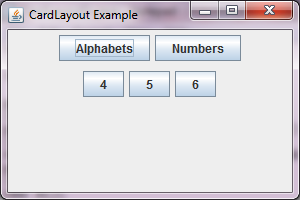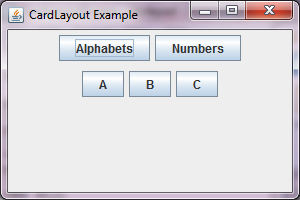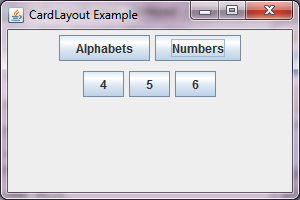Advertisement
| Constructor | Description |
|---|---|
| public CardLayout() | Creates a CardLayout with gap of size zero between the components.. |
| public CardLayout(int hGap, int vGap) | Creates a CardLayout with a specified number of gap between the components. |
| Methods | Description |
|---|---|
| public void first(Component comp) | This method flips to the first card in the container. |
| public void next(Component comp) | This method flips to the next card in the container. |
| public void last(Component comp) | This method flips to the last card in the container. |
| public void show(Component comp,String name) | This method shows a specific card in the container with a specific name. |
| public void setHgap(int horizontalGap) | This method sets the horizontal space between components. |
| public void setVgap(int verticalGap) | This method sets the vertical space between components. |
Advertisement
import javax.swing.*;
import java.awt.*;
import java.awt.event.*;
public class CardLayoutEx
{
public static void main(String... ar)
{
SwingUtilities.invokeLater(new Runnable() {
public void run()
{
new A();
}
});
}//Closing the main method
}//Closing the class A
class A implements ActionListener
{
JFrame jf;
JPanel parentPanel;
CardLayout cd;
A()
{
jf = new JFrame("CardLayout Example");
cd = new CardLayout();
//Creating a main parent panel that will contain two child panels
parentPanel = new JPanel();
//Creating two child panels.
JPanel childPanel1 = new JPanel();
JPanel childPanel2 = new JPanel();
JButton button1 = new JButton("Alphabets");
JButton button2 = new JButton("Numbers");
JButton button3 = new JButton("4");
JButton button4 = new JButton("5");
JButton button5 = new JButton("6");
//Adding buttons to childPanel1
childPanel1.add(button3);
childPanel1.add(button4);
childPanel1.add(button5);
JButton button6 = new JButton("A");
JButton button7 = new JButton("B");
JButton button8 = new JButton("C");
//Adding buttons to childPanel2
childPanel2.add(button6);
childPanel2.add(button7);
childPanel2.add(button8);
//Setting the positioning of the components in parentPanel, JPanel(that contains childPanel1 and childPanel2) to CardLayout
parentPanel.setLayout(cd);
//Adding childPanel1 and childPanel2 to parentPanel
parentPanel.add(childPanel1, "Num");
parentPanel.add(childPanel2, "Alp");
button1.addActionListener(this);
button2.addActionListener(this);
//Setting container JFrame's layout to FlowLayout.
jf.setLayout(new FlowLayout());
//Adding two buttons to JFrame, these buttons will remain commonly visible to all panels
jf.add(button1);
jf.add(button2);
//Adding JPanel, parentPanel to JFrame
jf.add(parentPanel);
jf.setSize(300,200);
jf.setVisible(true);
}
public void actionPerformed(ActionEvent ae)
{
//If "Numbers" button is clicked, open the JPanel with buttons showing numbers.
if(ae.getActionCommand()=="Numbers")
cd.show(parentPanel,"Num");
//If "Alphabets" button is clicked, open the JPanel with buttons showing alphabets.
if(ae.getActionCommand()=="Alphabets")
cd.show(parentPanel,"Alp");
}
}
 Figure 1.
Figure 1. Figure 2
Figure 2  Figure 3
Figure 3
Advertisement
Advertisement
Please check our latest addition
C#, PYTHON and DJANGO
Advertisement